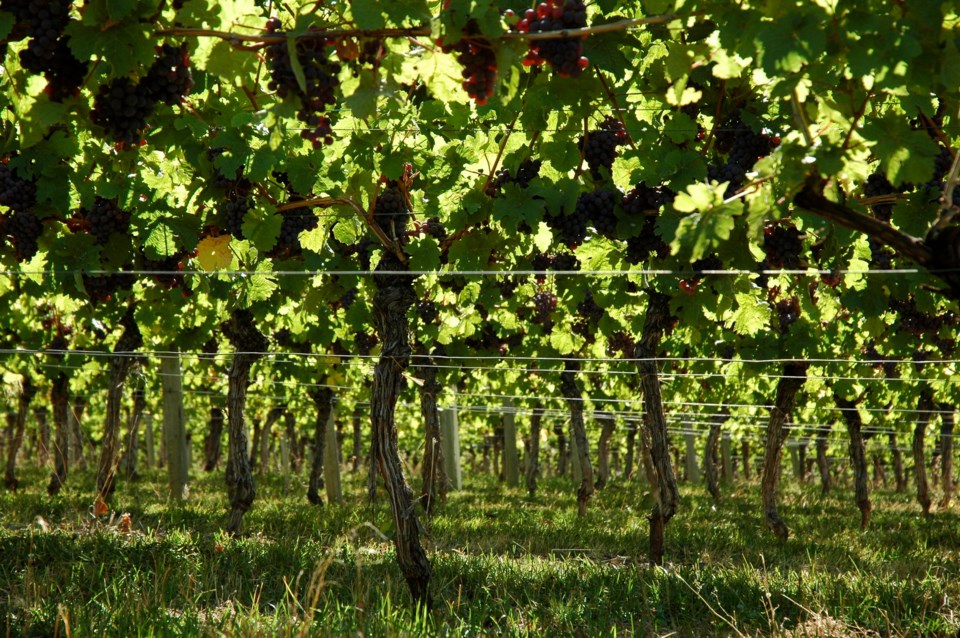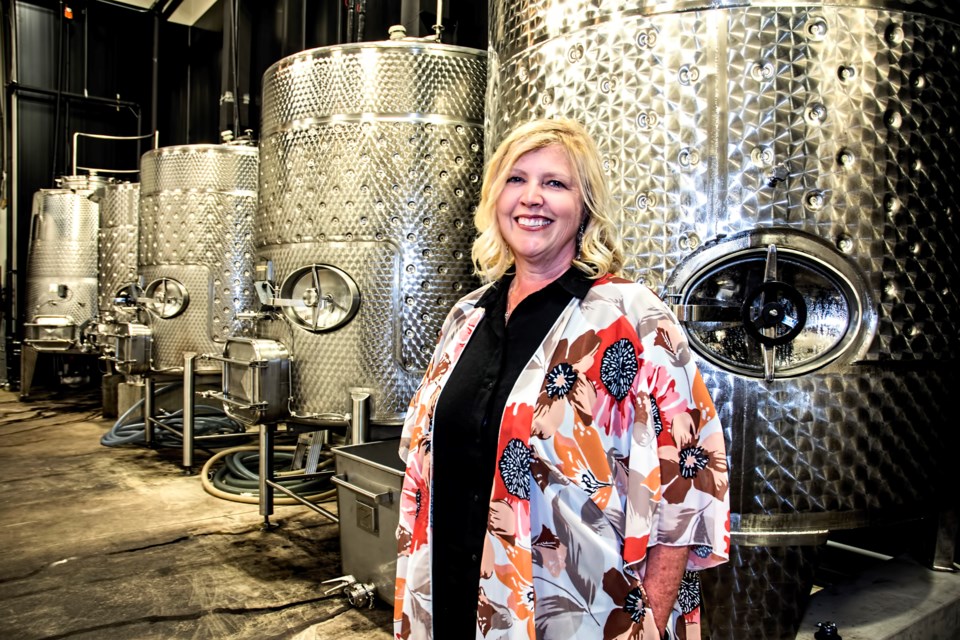Crushing tariffs and soaring costs are squeezing businesses in B.C.’s wine industry.
Winemakers, agents who import and resell wine and even retailers are facing pressure on multiple fronts.
“Everything is going up in price,” said Surrey-based Gate 22 Winery vice-president Christa-Lee McWatters. “There isn’t anywhere that we have not seen price increases.”
B.C.’s consumer price index rose by 30 basis points to reach an annual pace of 2.3 per cent in June.
Inflation has meant higher prices for labour, packaging, shipping and more.
The provincial government’s annual minimum wage increases have also added costs, even for businesses such as Gate 22 Winery, which pays workers more than minimum wage.
“When the minimum wage goes up, we have to proportionately increase everybody else’s wages as well, so it compounds even more,” McWatters said.
She recently ordered corks and screw-top closures and said she was shocked to see the final bill.
“The price has gone up,” she said. “With the exchange rate and the tariffs, we’re seeing another increase as well.”
Transportation and shipping costs have risen, she said.
Direct shipments of wine to consumers — usually wine-club members — is the most profitable sales channel for B.C. wineries because the B.C. government does not charge a mark-up fee on the wine’s base price. Getting those products to consumers, however, has become more expensive, McWatters said
“Like with Amazon, everybody wants free shipping, but the shipping rates are just continually increasing astronomically, and we can’t keep up with the increasing price. We have to eat some of those costs,” McWatters said.
Enotecca Wineries and Resorts Inc. managing partner Severine Pinte told BIV that one strategy to cut shipping costs implemented by Enotecca’s Le Vieux Pin winery was switching to glass bottles that weigh less. The new bottles are just as durable as heavier ones, but using them can cut the total weight of a bottle of wine by about one-third, she said.
That helped save the winery $35,000 in shipping costs last year, Pinte estimated.
Another cost savings has come from her company using technology to automate irrigation at nine Le Vieux Pin vineyards across the south Okanagan. That shift has enabled Pinte to operate with one fewer employee.
Still, some cost challenges have yet to be resolved.
Okanagan wineries have been grappling with drastically reduced grape yields due to two consecutive winters with deep freezes: In December 2022 and January 2024.
The B.C. government responded by creating a program to help compensate grape growers for replanting costs.
However, Pinte said that the program only offers funding to winemakers that plant specific certified vines.
Her winery’s replanting efforts include buying plants from European nurseries that have plants not certified by the Canadian Grapevine Certification Network (CGCN).
“We are not going to get any money from CGCN because our plants came from France,” she said.
Pinte said that this is the case despite her company being able to “tick all the boxes,” such as that her winery is certified as sustainable, and that it has a solid business plan for the next 20 years.
“This is a hurdle that we are working on,” she said. “It’s a work in progress.”

Tariffs hit wineries hard
Some B.C. winery executives responded to deep-freeze events by successfully lobbying the provincial government to change laws to enable them to buy Washington state grapes or juice so they can make wine in B.C. and keep people employed.
The cost to import grapes and juice from the U.S., however, has risen since the Canadian government levied retaliatory 25-per-cent tariffs in response to U.S. tariffs on Canadian goods.
While U.S. President Donald Trump later backtracked by allowing Canadian imports compliant with the Canada U.S.-Mexico Agreement (CUSMA) to enter the U.S. tariff free, Canada’s retaliatory tariffs remain in force on specific categories of U.S. goods — including grape must, or crushed grape juice — regardless of whether they are CUSMA compliant.
Lawyers tell industry players to get used to the new trade environment.
“There’s not going to be a quick snap-back,” said Miller Thomson LLP’s Â鶹´«Ã½Ó³»managing partner, Daniel Kiselbach.
“There is a competitive advantage to swiftly adapting to the new environment. So if you have the ways and means for swiftly adapting to the new environment, now the time to consider that.”
Blakes associate lawyer Brady Gordon told BIV that the reality for winemakers is that it is impossible to recategorize U.S. grape must or juice in a way to have it avoid Canadian tariffs.
Some manufactured goods can have components swapped out to change what governments consider to be the goods’ origin. That is not possible with grape juice because it is a core ingredient, he said.
Even with steep tariffs, some B.C. winemakers are likely thankful they are still allowed to import juice to make wine in B.C.
In contrast, wine agents and importers are banned from importing finished U.S. wines into the province because of a B.C. government decree.
This frustrates wine agent and Vintage West managing partner Matt Thirlwell, whose company generates about $35 million in wine wholesale sales.
His to sell to retailers via the British Columbia Liquor Distribution Branch (BCLDB,) he told BIV.
“There is no other good that is fully embargoed — anywhere in the entire country — like alcohol has been,” he said.
Thirlwell said he likes that Alberta and Saskatchewan have reversed their bans of U.S. alcohol and said he would like the B.C. government to follow suit.
He would then have to deal with 25-per-cent tariffs on the wine, which would make his imported products more expensive for consumers, but he would still be able to import wine for sale, he said.
“There are approximately 6,400 people employed in the agency side of the business in this country, and if you isolated that to U.S. wine and spirits, it represents over 700 jobs across the country,” Thirlwell said.
Lower alcohol consumption hits sector
Another significant challenge for the industry could be the fact that consumers are buying less alcohol.
That means that if the supply of wine remains the same, less demand will heighten competition among producers for customers.
One reason for reduced alcohol demand is that some consumers have shifted to legal cannabis. Some have decided to cut consumption back for health reasons. Others are drinking less to save money.
Whatever the reason, the downward trajectory of wine sales is clear.
The most recent BCLDB data shows that wine wholesale sales to pubs, restaurants, bars, government-owned stores and privately owned stores , compared with the same quarter in 2024.
Resellers purchased 13.96 million litres in that quarter, down 479,000 litres from Q1 2024.
Total wine wholesale sales in B.C. fell by a lower percentage because of inflation. Buyers spent nearly $225 million, which was 2.66 per cent (or $6.2 million) less than the $231 million in sales registered the year before.
Wholesale sales for B.C. wine fell by greater percentages by volume and in dollars, compared with the wine category as a whole in the quarter that ended in March.
That quarter followed a trend set last year.
In 2024, wine was the alcohol category where wholesale sales fell the most, by volume and by dollars spent. The declines were bigger than for other major alcohol categories, such as beer, spirits and refreshment beverages.
B.C. wholesale buyers spent $1.09 billion on wine in 2024, which was down 4.85 per cent from $1.15 billion in 2023.
By volume, sales fell by nearly 6.7 per cent.
Trade barriers limit direct-to-consumer sales
In the wake of Trump’s taunts about making Canada the United States’ 51st state, then-prime minister Justin Trudeau and current Prime Minister Mark Carney, along with provincial premiers, called for removing interprovincial trade barriers to stimulate domestic trade.
Little has changed so far.
Rhetoric about cutting red tape between provinces is music to the ears of B.C. winemakers, as .
All provinces, except P.E.I. and Newfoundland, on March 5 announced that they had agreed to remove obstacles that prevented their alcohol from being sold in other jurisdictions.
Time will tell what changes get enacted.
Wine Growers BC CEO Jeff Guignard told BIV that it has never made sense to him why it is easier to ship wine to Texas than it is to Alberta.
It all comes down to money, he said.
“Every government wants their tax revenue,” he said.
Alberta is the most recent province to allow direct-to-consumer sales between its residents and B.C. wineries, but it is one that has attracted Guignard’s ire, because of changes to tax policy.
B.C. and Alberta last summer hammered out a deal to allow B.C. wineries to register and get approved by the Alberta government to sell wine directly to Albertans.
The agreement held that wineries would calculate the Alberta tax on wine shipments and send that money directly to the Alberta government.
Many winery owners thought of the taxes as a small administrative fee.
The two governments’ agreement was that this system be in effect for one year. Winemakers such as Unsworth Vineyards sales and marketing director Chris Turyk told BIV that the registration process was relatively simple.
The government of Alberta then alerted B.C. winery principals that starting June 1, it would .
“You know, it’s good tax policy [if] we use a dead language to describe it, right?” Guignard quipped, referring to the tax’s Latin name.
The tax applies differently depending on whether the wine is priced at more than $15, $20 or $25, with higher mark-ups for pricier wines.
It means that any direct sales of B.C. wines to Alberta residents will face more tax, making the direct-to-consumer sales channel less desirable for sellers.
Alberta also hiked its administrative fee, Guignard said.
“If it’s going direct to consumer, from manufacturer to consumer, and not through a provincial wholesale system or any kind of provincial retail body, there should be either no taxes or some sort of flat fee,” he said.




